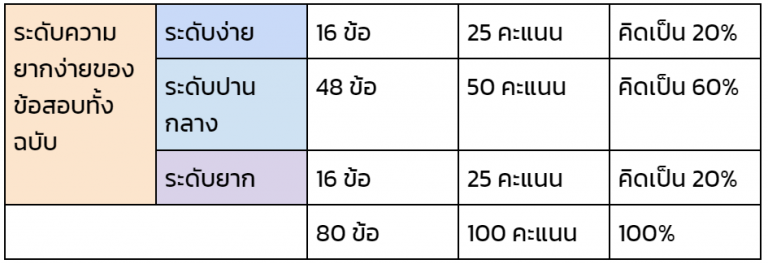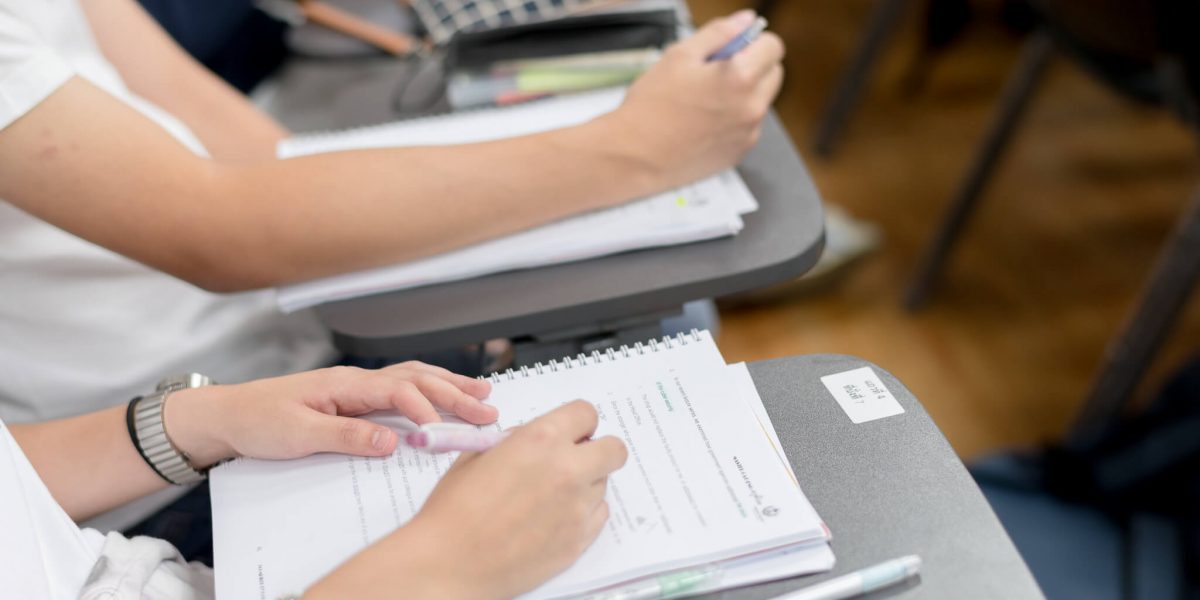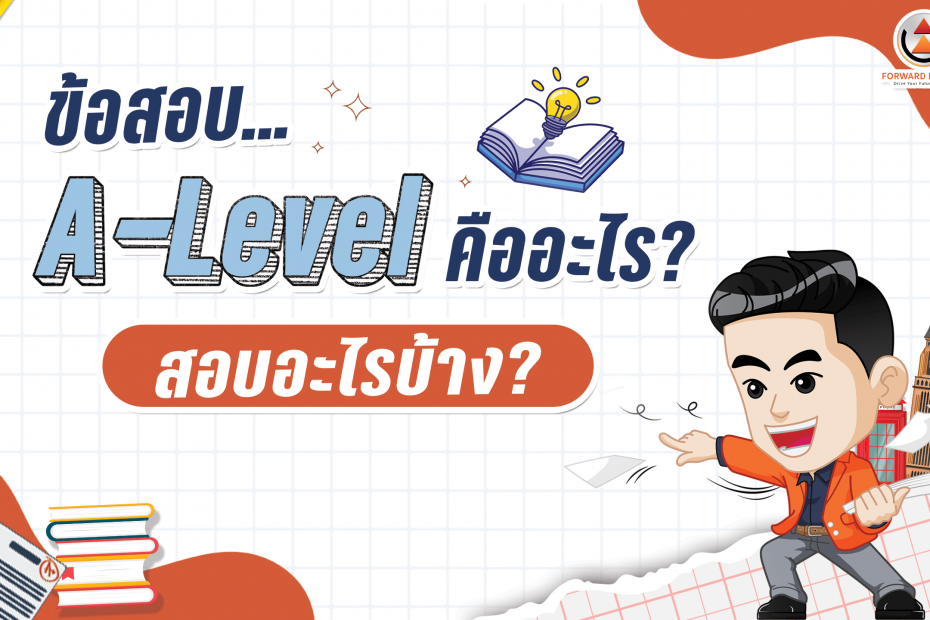ข้อสอบ A-Level (Applied Knowledge Level) คือ ข้อสอบวิชาสามัญแบบเดิมที่เคยออกสอบปีก่อนๆ นั้นเอง
โดยข้อสอบ A-Level 66 นี้จะวัดความรู้เชิงวิชาการของผู้สอบ เน้นไปที่การนำความรู้ที่น้องๆเรียนกันมาจากห้องเรียนไปประยุกต์และปรับใช้ในชีวิตจริง
ข้อสอบ A-Level สอบอะไรบ้าง
A-Level จะวัดระดับความรู้ของน้องๆ 10 วิชาด้วยกัน ได้แก่
- คณิตศาสตร์ประยุกต์ 1 (พื้นฐาน + เพิ่มเติม)
- คณิตศาสตร์ประยุกต์ 2 (พื้นฐาน)
- วิทยาศาสตร์ประยุกต์
- ฟิสิกส์
- เคมี
- ชีววิทยา
- ภาษาไทย
- สังคมศึกษา
| ค่าสมัครสอบ 100 บาท/วิชา | สอบวิชาละ 1 ชั่วโมง 30 นาที | คะแนนเต็มที่ 100 คะแนน/วิชา |
|---|
กำหนดการการสอบ A-Level 66 สำหรับปีการศึกษา 2566
| กำหนดการสอบ A-Level 66 | วันที่ |
|---|---|
| วันที่เปิดรับสมัคร | 1 - 10 กุมภาพันธ์ 2566 |
| วันประกาศที่นั่งสอบ | วันประกาศที่นั่งสอบ |
| วันสอบ A-Level | 18 - 20 มีนาคม 2566 |
| วันประกาศผลสอบ | รอประกาศ |
ตารางสอบ A-Level วิชาต่างๆ
| วันที่ | เวลา | ตารางสอบ A-Level |
|---|---|---|
| 18 มีนาคม 2566 | 08:30 - 10:00 | ชีววิทยา |
| 11:00 - 12:30 | ฟิสิกส์ | |
| 13:30 - 15:00 | ภาษาไทย | |
| 15:30 - 17:00 | สังคมศึกษา | |
| 19 มีนาคม 2566 | 08:30 - 10:00 | คณิตศาสตร์ 1 (เพิ่มเติม) |
| 11:00 - 12:30 | ภาษาอังกฤษ | |
| 13:30 - 15:00 | เคมี | |
| 20 มีนาคม 2566 | 08:30 - 10:00 | คณิตศาสตร์ประยุกต์ 2 (พื้นฐาน) |
| 11:00 - 12:30 | วิทยาศาสตร์ประยุกต์ | |
| 13:30 - 15:00 | ภาษาต่างประเทศอื่นๆ |
เอาล่ะครับน้องๆ เราได้ทำความรู้จักกับตัวข้อสอบ A-Level ปี 66 กันไปแล้ว พี่ว่าเรามาเน้นกันที่วิชาภาษาอังกฤษของเรากันดีกว่าครับ ส่วนตัว พี่คิดว่าข้อสอบ A-Level วิชาภาษาอังกฤษ นั้นไม่ได้ยากไปกว่า TGAT เลยครับ
หากน้องๆ สามารถทำข้อสอบ TGAT ได้ พี่คิดว่า A-Level น้องๆ ก็ต้องทำได้ดีไม่แพ้กันอย่างแน่นอน
มากไปกว่านั้น น้องๆสามารถเตรียมตัวครั้งเดียวแต่พร้อมสอบทั้ง TGAT , TPAT และ A-Level English เลยครับ
เพราะฉะนั้นแล้ว พี่อยากให้น้องๆ เตรียมตัวกันให้ดีๆ ส่วนพี่เองก็จะขอทำหน้าที่พาน้องๆไปทำความคุ้นเคยกับแนวหรือโครงสร้างข้อสอบ A-Level 66 วิชา ภาษาอังกฤษ เพื่อที่น้องๆจะได้ไม่พลาดรายละเอียดต่างๆที่มีความสำคัญ ซึ่งแน่นอนว่ามันจะส่งผลโดยตรงต่อความมีประสิทธิภาพในการเตรียมตัวสอบของน้องๆครับ
โครงสร้างข้อสอบ A-Level 66 วิชา ภาษาอังกฤษ

ข้อสอบส่วนทักษะการฟังและพูด (Listening and Speaking Skills) (20 ข้อ 25 คะแนน)
เทคนิคในการทำข้อสอบแนวบทสนทนาคือ ให้เราสวมบทบาทเป็นตัวบุคคลในบทสนทนานั้นๆ แล้วเลือกคำตอบที่ฟังดูเข้าท่าที่สุด
พยายามหา key words หรือคำที่สามารถให้ข้อมูลกับเราได้มากที่สุด
- บทสนทนาแบบสั้น (Short conversation) มีทั้งหมด 3 บทสนทนา แต่ละบทนทนา มี 4 ข้อ รวม 12 ข้อ แบ่งเป็น ง่าย 3 ข้อ กลาง 6 ข้อ ยาก 3 ข้อ
- บทสนทนาแบบยาว (Long conversation) มีทั้งหมด 1 บทสนทนา มี 8 ข้อ แบ่งเป็น ง่าย 1 ข้อ กลาง 6 ข้อ ยาก 1 ข้อ

ข้อสอบ A-Level 66 ส่วนการอ่าน (Reading Skill) (40 ข้อ 50 คะแนน)
โฆษณา (Advertisement)
คำศัพท์ที่มักเจอในพาร์ทนี้ มักจะเป็นคำศัพท์ที่พบเจอได้ทั่วไปในชีวิตประจำวัน น้องๆต้องพยายามมองบริบทของตัวโฆษณาให้ออก แล้วเดาจากบริบทนั้น
มีทั้งหมด 2 บทความ บทความละ 3 ข้อ ง่าย 2 ข้อ กลาง 2 ข้อ ยาก 2 ข้อ
บทวิจารณ์สินค้าหรือบริการ (Product or service review)
บริบทเป็นสิ่งที่สำคัญที่สุด น้องๆต้องเดาอารมณ์ของบทวิจารณ์ให้ออก มันจะทำให้น้องๆเดาคำศัพท์ได้ง่ายขึ้นมากๆ เช่น บทวิารณ์มีความเห็นเป็นบวก หรือลบ หรือเป็นกลาง เป็นต้น มีทั้งหมด 6 ข้อ ง่าย 1 ข้อ กลาง 4 ข้อ ยาก 1 ข้อ
รายงานข่าว (News report)
ขึ้นอยู่กับชนิดของข่าว น้องๆอาจเจอข่าวเศรษฐกิจ การเมือง วิทยาศาสตร์ ให้น้องๆใช้หลักการคิดแบบมีเหตุผล หาใจความสำคัญของข่าวให้เจอ มีทั้งหมด 6 ข้อ ง่าย 1 ข้อ กลาง 6 ข้อ ยาก 1 ข้อ
ภาพประกอบบทความ (Visual) เช่น กราฟ ตาราง แผนผัง หรือ แผนภูมิ
ดูภาพ และคำถามให้เคลียร์ อย่าโดนคำถามหลอก อย่าสับสนคำถามที่ถามถึงความเป็นปฏิเสธ
มีทั้งหมด 2 เรื่อง เรื่องละ 3 ข้อ ง่าย 2 ข้อ กลาง 2 ข้อ ยาก 2 ข้อ
บทความทั่วไป ที่ มีจำนวนคำประมา ณ 500– 600 คำ หรือ 1 หน้ากระดาษ A4
อ่านแบบ skim and scan แล้วหาใจความหลักให้เจอ
อ่านคำถามให้รอบคอบ อย่าโดนคำถามหลอก
มีทั้งหมด 2 บทความ บทความละ 8 ข้อ ง่าย 3 ข้อ กลาง 10 ข้อ ยาก 3 ข้อ

ทักษะการเขียน (Writing Skills) (20 ข้อ 25 คะแนน)
เติมบทความให้สมบูรณ์ (Text completion)
ในพาร์ทนี้ แน่นอนว่าน้องๆต้องกลับไปศึกษาทบทวนเรื่อง แกรมม่าหรือไวยากรณ์ให้แม่น โดยเฉพาะอย่างยิ่งเรื่อง Parts of speech หรือชนิดของคำที่ใช้ในส่วนต่างๆของประโยค นอกจากนี้ เรื่องของ connectors ต่างๆ ก็สำคัญไม่แพ้กัน
มีทั้งหมด 3 บทความ บทความละ 5 ข้อ ง่าย 2 ข้อ กลาง 11 ข้อ ยาก 2 ข้อ
เรียงประโยคให้เป็นย่อหน้าที่สมบูรณ์ (Paragraph organization)
ให้น้องๆ มองหา 3 ส่วนนี้ดีๆครับ ได้แก่
- ส่วนเริ่มต้น
- ส่วนขยายเนื้อหาหรือเนื้อความ
- ส่วนสรุป
เรียงลำดับ แล้วลองอ่านดูว่าเข้าใจดีหรือไม่ และนอกจากนั้น การหาคำที่สำคัญ(key word) ก็ช่วยให้เราทำได้ดีขึ้น
แบ่งเป็น 5 ย่อหน้า ย่อหน้าละ 5 ข้อ ง่าย 1 ข้อ กลาง 3 ข้อ ยาก 1 ข้อ
ตัวอย่างข้อสอบ A-level 66
ตัวอย่างข้อสอบ A-level ส่วนการฟังและการพูด
A : Hi B,_____(1)_____?
B : It’s called ‘I’m Okay. You’re Okay.’ It’s a self-help book.
A : _____(2)_____?
B : Well, it teaches you about accepting who you are and accepting others
for what they are too. So the relationship is smooth.
(1)
1.How late can you be
2.What are you reading
3.Where do you come from
4.Why are you in the library
(2)
1.Is that the way to go
2.How long does it take
3.Have you been in for long
4.What does it help you with
Part 2: Reading
(1) Passenger planes could be flown without a pilot in the next decade according to a new study.
(2) The research was conducted by investment bank UBS, which found that new technology is being developed that would make remotely flying an aircraft feasible in the near future.
(3) Pilotless planes could be a boon for airlines as it would save them 27 billion pounds and slash fares for passengers, who could see prices drop by over 10 percent. The report said : “The average percentage of total cost and average benefit that could be passed onto passengers in price reduction for the US airlines is 11 percent” Savings on European flights would be less at an average of 4percent.
(4) The biggest savings will come from reducing the cost of employing pilots. UBS estimated that pilots cost the industry 24 billion pounds a year. The study predicts flights will be safer as the potential for pilot error will be removed.
(5) Air passengers, however, seem nervous about traveling in a remote controlled plane.More than half of the 8,000 people surveyed by UBS (54 percent) said they would refuse to fly in a plane with no pilot, even if the flight cost less.
(6) Respondents between 18 and 34 and those who had a university degree were more willing to fly without a pilot. The report said: “This bodes well for the technology as the population ages.”
(7) UBS suggested that initially the traditional two pilot set-up will be reduced to one on board pilot and one pilot on the ground. Commercial jets already use computers for many functions including take-off, cruise and landing.
(8) However, not everyone is so convinced by these technological developments. Steve Landells, BALPA flight safety specialist and former pilot, said : “We have concerns that in the excitement of this futuristic idea, some may be forgetting the reality of pilotless air travel. Computers can fail, and often do, and someone is still going to be needed to work that computer. Most of us own some sort of electronic device that can do amazing things -however, a human is still required to operate it.”
(1) What would be the best headline for this article?
1.Passengers Dissatisfied with Pilotless Planes
2.Billions of Pounds Saved Using Pilotless Planes
3.UBS’s Research on Safety of Remote Controlled Aircraft
4.Remote Controlled Aircraft Coming But Not Everyone Approves
(2) What are paragraphs 3 and 4 mainly about?
1.Passengers’ safety
2.The aviation industry
3.Aircraft manufacturers
4.Benefits of pilotless planes
(3) How does Steve Landells feel about the pilotless flight?
1.Worried
2.Bored
3.Satisfied
4.Responsible
(4) According to paragraph 6, what do the survey results indicate?
1.All air passengers are worried about safety.
2.The pilotless planes will continue to improve.
3.Different groups accept this technology equally.
4.Younger people are more accepting of this innovation.
Part 3: Writing
What if you had one shot one opportunity — to seize everything you ever wanted in one grueling nine-hour exam? Would you capture it, or ____(1)____ and start crying? That’s the situation millions of ____(2)____ face every June with the dreaded Gao Kao, a two-day test said to be the hardest in the world. The comprehensive exam____(3)____ everything the students have ever learned in order to match them to a college and chart the rest of their lives. It’s seen in Chinese society____(4)____ an all-important step to attending a prestigious university and landing a high-paying job afterward. In some cases, it can even be a stepping stone to____(5)____ one’s social status.
(1)
1.blow your stack
2.get into a fight
3.act high and mighty
4.curl up into a tiny ball
(2)
1.senior Chinese high school
2.high school Chinese seniors
3.high school senior Chinese
4.Chinese high school seniors
(3)
1.evaluates
2.is evaluating
3.evaluated
4.is evaluated
(4)
1.for
2.like
3.as
4.in
(5)
1.leading
2.elevating
3.descending
4.following
เฉลย
Part 1:
Listening and Speaking
1) 2.What are you reading (คุณกำลังอ่านอะไรอยู่)
เพราะ B ตอบว่า It’s a self-help book (หนังสือที่อ่านแล้วเอาความรู้ไปช่วยตัวเอง)
A จึงต้องถามไปว่า อ่านอะไรอยู่ นั่นเอง
2) 4.What does it help you with (มันช่วยคุณในเรื่องอะไร)
เพราะ B อธิบายว่าหนังสือเล่นนี้มัน teaches (สอน) เค้าว่าอะไรบ้าง
A จึงต้องถามว่า หนังสือเล่มนี้มันช่วยเรื่องอะไร นั่นเอง
Part 2:
Reading
1) 4.Remote Controlled Aircraft Coming But Not Everyone Approves
(เครื่องบินที่ถูกควบคุมด้วยรีโมทกำลังอยู่ในกระแส แต่ก็ไม่ได้หมายความว่าทุกๆคนจะเห็นด้วยไปเสียหมด)
หากอ่านเนื้อเรื่องแบบคร่าวๆ จะพบว่า เนื้อเรื่องทั้งหมดนั้นเกี่ยวข้องกับเครื่องบินที่ถูกควบคุมด้วยรีโมท
แต่ย่อหน้าที่ 8 ซึ่งเป็นย่อหน้าสรุป เค้าใช้คำว่า However, not everyone is so convinced ซึ่งแปลว่า ยังมีคนไม่เห็นด้วยอยู่ นั่นเอง
2) 4.Benefits of pilotless planes (ข้อดีของเครื่องบินที่ไร้คนขับ)
Keyword อยู่ที่คำว่า boon ซึ่งเป็นคำพ้องความหมายของ benefit เลยครับ แปลเหมือนกันเลย
นอกจากนั้นยังมีคำว่า Saving ที่บ่งบอกว่าเป็นข้อดี และยังมีการบอกถึงเรื่องความปลอดภัยด้วยคำว่า safer และ pilot error will be removed
3) 1.Worried (รู้สึกกังวล)
เนื่องจาก Steve Landells ได้กล่าวในย่อหน้าที่ 8 “We have concerns..” เป็นการแสดงความกังวล
4) 4.Younger people are more accepting of this innovation.
(คนหนุ่มสาวยอมรับเทคโนโลยี นี้มากกว่าคนรุ่นเก่า)
สังเกตุได้จากย่อหน้าที่ 6 ที่บอกว่า ผู้คนช่วงอายุ 18 – 34 ปี (หนุ่มสาว) นั้น willing หรือที่แปลว่า เต็มใจที่จะ fly without a pilot หรือ บินกับเครื่องบินที่ไม่มีคนขับ นั่นเอง
Part 3:
Writing
1) 4.curl up into a tiny ball(มัดตัวหรือม้วนตัวให้เล็กๆ กลมๆเหมือนลูกบอล)
วลีนี้มักใช้ในแง่ของการแสดงอารมณ์น้อยใจ แง่งอน ไม่พอใจ จึงเหมาะที่สุดและตรงกับบริบทของบทความที่สุด
2) 4.Chinese high school seniors (รุ่นพี่ที่โรงเรียนมัธยมชาวจีน)
การเรียงตำแหน่งของคำนามและคำคุณศัพท์ มีหลักการง่ายๆ คือ
คำนามหลักจะอยู่ท้ายสุด คำขยายจะอยู่ข้างหน้า ซึ่งในที่นี้ คำนามหลักคือ High school seniors มีคำว่า Chinese ซึ่งเป็น adj. มาขยาย จึงวางไว้ข้างหน้า
3) 1.evaluates (ประเมิน)
ดู Tense โดยรวมจากทั้งประโยคนี้ เราจะพบว่า Clause หรืออนุประโยคใช้ Present perfect เพราะฉะนั้น กริยาหลัก ก็ควรเป็น present ด้วย และในที่นี้ the comprehensive exam เป็นประธานทำกริยา evaluate เอง จึงใช้ active voice ไม่ใช่ passive voice
4) 3.as
มาจากวลีที่ว่า seen as something
เราจึงต้องตอบ seen as an all-important step
5) 2.elevating
elevating คำศัพท์ที่เหมาะกับบริบท ให้ความหมายว่า “ยกระดับ” one’s social
